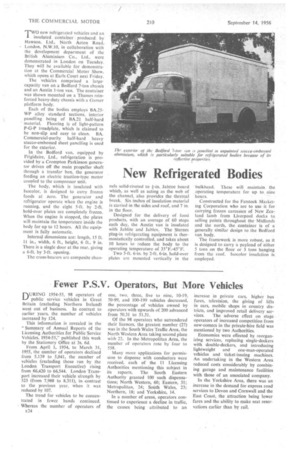Fewer P.S.V. Operators, But More Vehicles
Page 114

If you've noticed an error in this article please click here to report it so we can fix it.
DURING 1954-55, 98 operators of public service vehicles in Great Britain (excluding Northern Ireland) went out of business. In contrast to earlier years, the number of vehicles increased by 124.
This information is revealed in the "Summary of Annual Reports of the Licensing Authorities for Public Service Vehicles, 1954-55," published this week by the Stationery Office at 3s. 6d.
From April 1, 1954, to March 31, 1955, the number of operators declined from 5.139 to 5,041, the number of vehicles (excluding those run by the London Transport Executive) rising from 66,420 to 66,544. London Transport increased their vehicle strength by 323 (from 7.988 to 8,311), in -contrast to the previous year, when it was reduced by 107.
The trend for vehicles to be concentrated in fewer hands continued. Whereas the number of operators of a24 one, two, three, five to nine, 10-19, 50-99, and 100-199 vehicles decreased, the percentage of vehicles owned by operators with upwards of 200 advanced from 50.31 to 51.31.
Of the 98 operators who surrendered their licences, the greatest number (27) was in the South Wales Traffic Area, the North Western Area taking second place with 22. In the Metropolitan Area, the number of operators rose by four to 558.
Many more applications for permission to dispense with_ conductors were received, each of the II Licensing Authorities mentioning this subject in its reports. The South Eastern Authority granted 100 such dispensations; North Western, 60; Eastern, 31; Metropolitan, 24; Sonth Wales, 23; Northern, 18; and Yorkshire, 14.
In a number of areas, operators continued to experience a decline in traffic, the causes being attributed to an increase in private cars, higher bus fares, television, the giving of lifts in cars, mobile shops in country districts, and improved retail delivery ser vices. The adverse effect on stage operators of increased competition from new-corners in the private-hire field was mentioned by two Authorities.
Economies were effected by reorganizing services, replacing single-de-ckers with double-deckers, and introducing lightweight and one-man-operated vehicles and ticket-issuing machines. An undertaking in the Western Area reduced costs considerably by combining garage and maintenance facilities with those of an associated company.
In the Yorkshire Area, there was an increase in the demand for express road services to Devon and Cornwall and the East Coast, the attraction being lower fares and the ability to make seat reservations earlier than by rail.












































































































































































































